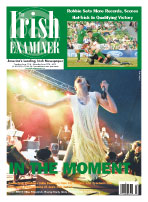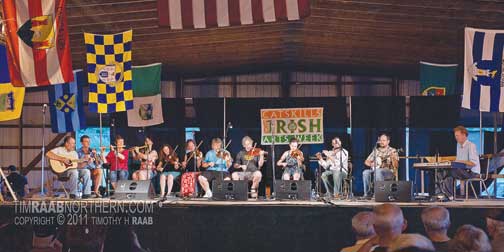


SERVICES
Tuesday July 3, 2012
Partying In The Catskills
A concert during last year's CIAW (Tim Raab) By Gwen Orel "It's incredible to see, when like minds get together, what they can do," says Joanie Madden of Cherish the Ladies. She appears in the two minute video in the Rally Around the Catskills Kickstarter campaign video with Artistic Director Paul Keating, encouraging those who love the week of music and dance classes, ceilidhs and craic to donate a little (and get a pledge gift, a la PBS) to keep the week alive. In its first week of operation, Catskills Irish Arts Week (CIAW) met its $10,000 goal. As of this writing, it's at over $15,000, with over 180 backers. People were quick to rally (and please continue: going over its goal will make it easier next year). As Paul says with a laugh, support is "typically Irish" in that it often comes at the last minute). For Paul, Kickstarter has been like an Irish mehil, when neighbors come together to help out. "This is a mehil project for CIAW," he says. It's true: I think I received at least three separate emails about it from teachers, players, friends. I put the campaign on the New York Irish Arts blog. And I pledged myself. There are great incentives, including copies of the upcoming double CD Craic in the Catskills 2012 that will be made from the performers this summer, skype lessons with music teachers, autographed copies of books and CDs from Matt Cranitch, Fintan Vallely, and, for the largest pledge, a house concert with Cherish the Ladies. You can pledge $1. You can pledge thousands. Now in its 18th summer, Catskills Irish Arts Week (July 15 - 21 this summer) has a touch of fairy dust about it. If it touches you, you're hooked. Young fiddler Dylan Foley, 20, who just released his first solo CD Hup!, observes that people are often depressed when the week is over. It's true: I remember last summer shortly after the week going to see Maeve Donnelly and Conal Ó'Gráda, who had both been teachers during the week, in the city, and bumping into a bunch of people from the week there. A friend who accompanied me asked if we always traveled in groups like that. I said no, but after the Catskills, nobody wants to say goodbye. He spent many of his summers growing up at the week in East Durham. So did Dan Gurney, 25. Dan also just released an album, Traditional Irish Music on the Button Accordion. Both will be on staff, planning, as Paul calls it, "late night fun who inhabit the night at the Catskills." To see the younger generation playing up there each summer particularly entrances Paul. This traditional music clearly has an ongoing tradition. Though not that long ago, in the mid-twentieth century, there were real fears that the music would die out, there seems to be little danger of that now. The children start young: Dylan remembers going when he was too little to play, participating in the kids' workshops while his parents took classes. And it's not uncommon in a music class to see a whiz-kid 10-year old picking up tunes next to an adult 50 years older. The teachers range in age too. Chrissy Crowley, new to the Catskills this summer, is a Cape Breton fiddler who just 22. Paul first saw her at the festival Celtic Colours International Festival on Cape Breton Island when she was just 15, and was impressed by her spirit and commitment to the music. Cathal McConnell, who will be teaching singing, is 66. He's one of the founding members of the legendary Boys of the Lough, founded in 1967. He will be launching his collection of songs I Have Traveled This Country, a collection of his repertoire. "I've been dying to get him for years," Paul acknowledges. "He's just ready-made for the Catskills. He lives and breathes Irish music, and he has a very endearing way of storytelling to go along with the songs." In the Catskills, you can take classes with him, or just go to his performances. This opportunity to rub shoulders with the greatest players is one of the strong appeals of the week. You'll see these players in classes, in sessions (which go on all night), and in nightly concerts. Sessions are structured in different roadhouses around town, always with some of the staff leading, and organized by level: some are intermediate, some are "listening rooms," some are advanced. If you know nobody, you'll soon find your feet and find your way around. But if you've been before, it's like a homecoming. There are people you know from sessions, people you know from previous summers who live across the country, people from Ireland you studied with the summer before. And it's like no time has passed at all as you leap into a tune together, or share a pint or a joke. And that, says Paul, is very much in the tradition of the Catskills. For decades, he explains, the area served the Irish-American community as a summer community, not too far from New York or Boston. It was a place of reunion for man families celebrating their Irish-American heritage. "It's a unique place to situate traditional music and dance classes," he says. The facilities, he says, are historic. "There are beautiful timber floors, with great sound and give, lift, for ceilidhs. They are great places to convene too, because there usually is a bar around the corner. The Shamrock house is ideal.
12 year old Dylan Foley (Tim Raab) "Pubs can be small and intimate, just right for different sized gatherings and music sessions. They are reminiscent of what it was like over the years. If those walls could talk, they would tell the history of Irish America and the musicians who might have played there, Andy McGann, Joe Burke. The students rub shoulders with all the performers there." There are the foundation, the great teachers from the New York area who are there every year, including Patty Furlong, Tony DeMarco, Rose Flanagan, Margie Mulvihill, Billy McComiskey, Iris Nevins, Willie Kelly, and more. Paul points out that this really is a New York Festival, and many of the New York teachers help organize, and encouragetheir own students to come up and study with someone else. There are regulars from Ireland, including Matt Cranitch and Paul DeGrae. And Paul always switches it up by rotating teachers through. Cork singer Jimmy Crowley will teach bouzouki. Máirtín De Cógáin will teach storytelling, and join Jimmy onstage, and, says Paul, fellow Corkonian Donie Carroll will join them for a set or two. Michael Black, of the Black family, will be teaching singing. Dermot Byrne, of Altan, will be teaching button accordion, and releasing his new CD with French harpist Floriane Blancke, who is teaching harp. But really, once you begin listing teachers, how do you stop? It's an incredible roster. What there isn't: a lot of modern conveniences. "It's rustic," Paul says with a laugh. "There are not a lot of amenities that have exploded in the small hotel inns that proliferate the highways and byways now." Do bring your bug spray and a portable fan. What there also isn't: sleep. "It's an endurance test," Paul admits. The week flies by quickly. The garden at the Blackthorne Resort, run by Yvonne Furlong, promises to be a site where before you know it the sun comes up, once again. She and husband Tom ran Furlong's Pub until Tom had a stroke. The spirit of that pub continues on. Joanie Madden is a regular: last year I left the pub at 8 am and Joanie was still chatting energetically at the bar. In addition to music, there are lectures that shed light on the tradition. Fiddler Jesse Smith last year gave an amazing lecture on the phrasing of Michael Coleman (we're all waiting for the book). This year Fintan Vallely, a well-respected Irish writer, also a flute player, will speak about his book, the revised edition of The Companion to Traditional Irish Music. Paul is excited to launch it. At almost 900 pages, the book, he says, is "extraordinary. It's a must have kind of book for anyboy serious about it. We'll be hearing from Fintan himself about how he put it together." The Catskills are designed to have the atmosphere of an Irish village. You can take classes in the morning and afternoon, in the same instrument, or on different ones. And if you can't take the whole week off, you can go for just a couple of days and, says Paul, even register for a per diem class. Come for one night and go to a session and ceilidh. That freedom and flexibility is part of the great charm of this country retreat. The roadhouses and pubs stretch out over ten miles of rolling green hills and roads with Queen Anne's Lace and wildflowers popping over them. There's dew on the grass as you go to a late night session. There are bright stars on a black sky that remind you yes, you are out of the city. Many people, says Paul, book their accommodations for the next year as they are leaving. You won't want to go home. And when you do, you'll know you are going back. Gwen Orel runs the blog and podcast New York Irish Arts |
CURRENT ISSUE

RECENT ISSUES


SYNDICATE
[What is this?]
POWERED BY

HOSTED BY

Terms of Service | Privacy Policy
Website Design By C3I







